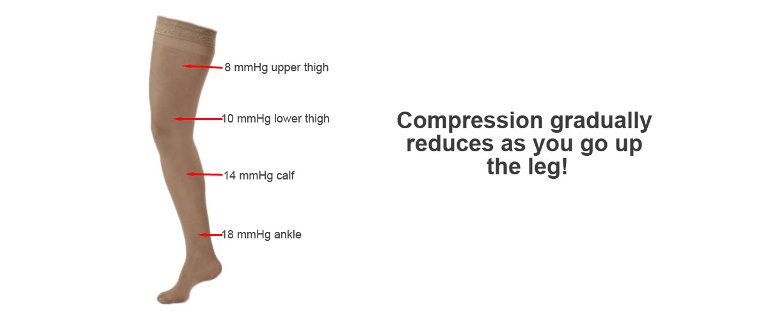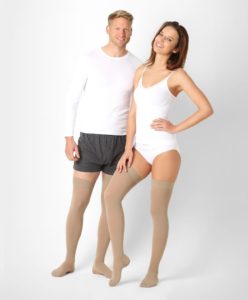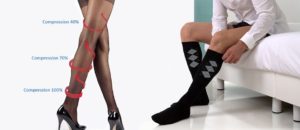Compression therapy is becoming a commonplace in the world of physical therapy in addressing conditions like lymphatic and venous insufficiency in the lower limbs, ulceration, postthrombotic syndrome, varicosities, venous eczema, and deep vein thrombosis. Even though there are many prescriptions from therapists, the prescriptions of graduated compression socks are the leading type.
They are relatively more comfortable to wear and far better than pneumatic devices and bandaging. Not that alone, the understanding of graduated compression socks is broad. Therefore, those who get the prescription or who would get it, later on, should understand every essential information about graduated compression stockings.
This article will provide answers to all the burning questions you could have about graduated compression socks, helping you to understand what it is and what it’s not. While it wouldn’t address all the questions you have about graduated compression stockings, it will be excellent to highlight the basic and essential ones. So, relax and read on!
Graduated Compression Stockings

Graduated socks are often used in treating chronic edema and venous disease. They exert the highest degree of compression at the ankle, and the level or rate of compression decreases gradually up the gear. Besides, graduated compression socks are manufactured for ambulatory folks, and also, they are designed under technical and strict specifications, including durability and consistency, so that they will provide a particular level of graduation and ankle pressure.
In reality, graduated compression stockings are unique and special socks that would aid in promoting circulation in your legs. You see, in the veins in your leg, the flow of blood must be upward to the heart, with folks with risk factors and complications, graduated compression is used in applying specific level or amount of pressure close to your ankle and steadily apply less pressure, and they transmit them up the leg.
This way, they will efficiently or effectively push back blood up the leg of the ankle to the thigh, to counteract blood pooling in the feet.
Graduated socks aren’t limited to a particular gender. They are designed for both men and women, and they are available in several versions. These versions include:
- Thigh-high
- Pantyhose
- Knee highs.
The prescription usually comes in millimeters of mercury (mmHg), and this stands for the amount of pressure that is exerted in your legs by the socks. The gradient pressure is often high at the ankle and lessens up the leg. In most cases, your physician will prescribe to you the exact version that is right for you. It must be noted that the right fit of the compression level will surely work effectively. Hence, measurements must be accurately taken to be sure that a proper fit is maintained.
Patients who have had a blood clot in the leg have been tremendously helped. Moreover, graduated socks have manifested themselves to limit the risk of developing the post-thrombotic syndrome and preventing the risk of having DVT.
For certainty, the post-thrombotic syndrome is undoubtedly a painful condition that happens to some patients who have had a blood clot in their leg. Further, graduated compression stockings are entirely accurate in reducing the swelling for patients with post-thrombotic syndrome.
There are some cases where graduated compression socks might be prescribed to halt the occurrence of DVT in patients that have never experienced it but have the tendency of having it. For instance, a physician could ask that the patient wear graduated compression socks immediately after surgery. Due to sickness or other factors, a bedridden patient might be given compression socks too.
How Should a Person Wear Graduated Socks?

If the pain is your leg is severe, and you have significant swelling, the application of graduated compression socks might be difficult. To make the wearing easier, you should first lie down and elevate your feet off your heart level for a few minutes, so you will limit the swelling in your ankles and legs as much as possible. After that, wear the stockings the way you’d want to wear any pair of socks or pantyhose.
For amazing tips to help you get the best result from graduated compression socks, you should master these:
- Wear graduated compression socks daily.
- Use rubber gloves to help you grip the fabric better.
- If wearing it all day isn’t something you could do, then wear them for a few hours and gradually increase the time daily.
- First thing in the morning, wear your compression socks.
- If you have moist skin, apply grease-free powder or cornstarch.
- Keep feet and legs warm to enhance proper circulation.
- Socks should be replaced in between 3-6 months.
- Proper fit is essential for maximum effectiveness
- Weight loss and weight gain will affect your fit.
- Pay special attention to washing instructions
- Don’t alter or cut the socks
- Never roll or fold them down
- Get rid of the stockings if there are an extended tingling, numbness, and discolorations.
- Disallow wrinkles.
Now, it would be impressive to explore further mechanisms of graduated compression socks. Graduated compression socks are capable of reversing venous hypertension, facilitate the venous return, augment skeletal-muscle pump, and enhance lymphatic drainage.
It additionally initiates complex biochemical and physiologic effects that involve the venous, lymphatic, and arterial system. In one study where near-infused spectroscopy is used to monitor alterations in tissue deoxyhemoglobin and oxyhemoglobin, it was reported that the limb oxygenation had an increase with the use of graduated compression socks, most importantly with high compression socks. In another study, however, it was shown that the levels of proinflammatory cytokines in ulcer tissues in people with active ulcers had a significant reduction with the application of compression socks.
Now with this knowledge, let’s examine another aspect of compression socks – the graduation of compression strength.
Popular Articles on ComproGear
Compression Socks for Swollen Feet comprogear.com/compression-socks-for-swollen-feet/
Super Plus Size Compression Stockings comprogear.com/super-plus-size-compression-stockings/
Medical Compression Socks comprogear.com/medical-compression-socks/
Best Compression Socks for Ankle Swelling comprogear.com/best-compression-socks-for-ankle-swelling/
Compression Socks for Gout comprogear.com/compression-socks-for-gout/
Best Compression Socks for Nurses comprogear.com/best-compression-socks-for-nurses/
Compression Leg Sleeves comprogear.com/compression-leg-sleeves/
How the Strength of Compression Socks is Graded

The classification of graduation compression stockings is according to sub-bandage compression pressure exerted by the garment at the ankle region. The pressure is usually determined by the manufacturer based on measurements derived in the laboratory. The degree of pressure is done in different standards.
While there is no single standard that’s being approved globally, in general, they’re classes we can section them into. Consider the following:
- Class I (Low Compression): < 20mmHg
- Class II (Medium Compression): 20-30mmHg
- Class III (Higher Compression): > 30mmHg
Several factors influence the general pressure. These include:
The shape and size of the wearer’s legs
Stiffness and elasticity of socks material
Activities and movements of the wearer.
How Graduated Compression Socks could be sourced
The process would begin with your healthcare provider so you can find the graduated compression socks that are perfect for you. Your physician will inform you of the right pressure grade that should be purchased. Also, the physician will recommend an authorized seller or manufacturer that would measure and get you fitting socks. He or she will ensure recommended those who can give you the right education regarding your levels.
If you’d want to measure your size, you might need to do that with the instructions of your physician who will then prescribe you a specific pressure grade. Then, at a local pharmacy or online, you would be able to find your fit.
Problems Associated with the use of Graduated Compression Socks

Complications and Contraindications
Compression Socks are often safe to use, and they come with relatively low complications. However, poorly fitting graduated compression socks can lead to discomfort and pressure necrosis. Also, the use of graduated compression socks on legs that have impaired arterial flow could lead to ischemia. Some patients who are allergic to socks material could develop contact dermatitis, blistering, and discoloration.
Regardless, the wide array of complications of compression socks could be avoided if patients take extra care to measure accurately and assess their cases thoroughly. In the event of complications, a few folks might want to refit the socks, reduce the degree of compression, replace the material, and refit the socks. Accurate measurements that go in line with the manufacturer you want to purchase from must be done, at least for the first time, by an expert.
Noncompliance
The noncompliance rate for graduated compression socks has been said to be about 30%-65%. Most of the people say they did due to excessive heat, appearance, cost, pain, difficulty donning, perceived ineffectiveness, or discomfort.
If you desire to halt the use of graduated socks, you shouldn’t be timid to tell clinicians why you want to. This is because, in most cases, some factors could be amended by a simple change in the socks material, lowering the degree of compression, providing adequate detail, and further reassurance that you will be fine.
If you are visiting a doctor, this is the information you’d be given. They are:
- The reason the graduated compression socks have been prescribed
- The benefits of regular wearing
- How to accurately apply them
- Time to take it off
- Daily hygiene
- When it must be replaced
- The duration of wearing all-day
- Ways to identify potential problems.
- Who or what to do when problems occur.
Noting all these questions, you will have a smooth session from your physicians.
Other Vital Points to note about Graduated Compression Socks
Vein treatment patients must always put on graduated compression socks either before and after their treatment. Undoubtedly, these socks are the gold standard for the effective management of signs of venous disease and symptoms.
When selecting compression socks. Several styles and brands profess to be graduated compression socks, and in the real sense, they are not. So, even if a product says its graduated, it doesn’t signify graduation, it does signify graduation if it has a compression class such as this: “18-20mmHg.”
The graduation is optimally done to assist the calf muscle. And it efficiently works when the compression is high at the calf at 70% and reaches 40% at the thigh-high. When in the pharmacy to get a compression sock, be careful with levels of compression you see. There isn’t a specific way to identify how much compression sock you are you will get unless you measure and inquire from your doctor.
In an ideal setting, socks should be fitted by a certified fitter, a person who has been certified and taught about how to size a leg. The socks must be equipped with measuring in the early hours of the day. Also, when selecting the right graduated compression socks, ensure that you check if they have ISO certification. What does that mean? It does refer to an international quality control standard, which is the peak evaluation for medical devices to ensure that users and potential users are buying one of the highest quality products.
You must pay careful attention to the company where you are getting the graduated compression socks. Why? Many wearers complain about some brands. Some new manufacturers aren’t relieving the problem, making complaints more rampant.
Therefore, either you are a patient or a person who desires to prevent a problem, do all you can by applying all considered in this part to get your compression fit, and ensure that you are getting the medical-grade quality that should be given to you.
Conclusion
Even though there might still be some questions about the application of graduated compression socks, this article has treated the fundamental part as promised. Also, there is high-quality evidence that backs up that the use of graduated compression socks for patients with ulcers, chronic venous insufficiency, and other complications have found great relief. Besides, there is moderate quality for the prophylactic effect of the socks against DVT in patients that are medically sick. In contrast, there is low-quality evidence in orthopedic and general surgical patients.
Conclusively, graduated compression socks are very efficient for long-term maintenance of volume in lymphedema. However, for superficial thrombophlebitis, there could be some advantages from wearing graduated compression socks as some patients have related positive experiences.
It’s indeed a fantastic experience to use graduated compression socks in the right way. Also, since graduated compression socks are way different from other types of compression therapy, you must pay close attention to your level, your risk factors, your tolerance, and related questions.
